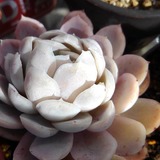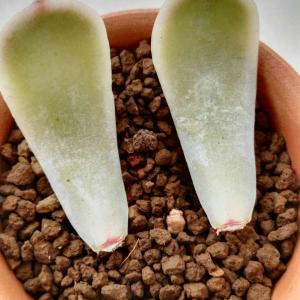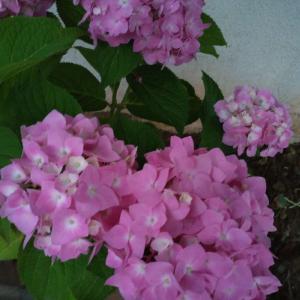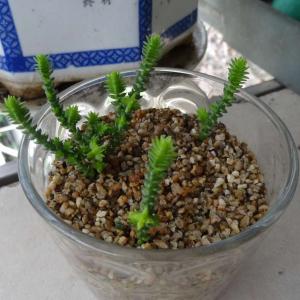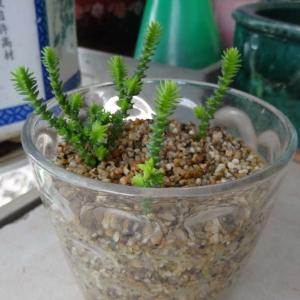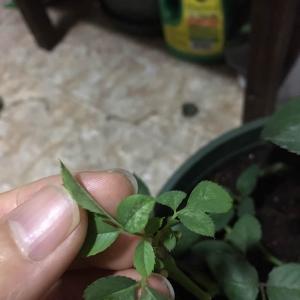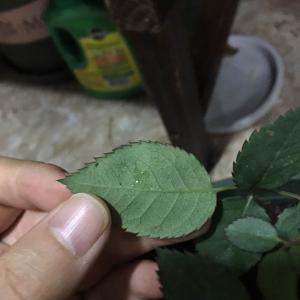文章
权问薇
2018年05月26日


一、、播种步骤
1、准备一个盆口较浅的容器,底部留有排水口,陶土盆最佳;
2、准备松软稀疏的砂质腐叶土,进行消毒处理。
3、将消毒后的土放入盆里,放上春羽的种子,覆一层薄土。
4、种下种子后的盆土要保持湿润,喷洒的方式进行给水,不要用大水,容易冲刷掉种子,也容易造成过涝,影响种子成活率。
5、将盆栽放到温暖湿润的环境中,春夏季节室温就可以,控制到23℃到26℃之间最佳。
6、种下保持正确的养护方法,大约两周后节能发芽。

二、后期养护
1、换盆
幼芽长成小苗,当苗高长到五公分的时候可以进行分盆,在春季进行。准备好要移植的容器,放入泥炭土、河沙、腐殖土等材料混合形成,并施加少量氨肥。
换盆后小苗会进行自我缓解,进入快速成长时期。这个时候保证水分的充足,除了适量浇水之后要从叶面喷撒式浇水,保证空气湿度,避免叶子干枯失去观赏价值。冬季浇水要控制次数,盆土表面变干在给水即可。
2、春羽耐阴,正常放在室内半个月左右也能生长,但是夏季空气温度高、蒸腾作用比较强,应该进行遮光处理,放置在半阴、通风的状态下,这样做也是为了避免叶面被强光灼伤。
3、生长期约一个月左右使用一次肥料补充营养。可以选择有机液肥,薄肥就可以。也可以浇淘米水、浓度较低的鱼血水。
4、冬天温度过低,为防止冻坏,要转移到室内,放置在向阳的窗边。

0
0
文章
Miss Chen
2018年05月25日

Description: This perennial plant is 1-3' tall, branching occasionally in the upper half. The light green to reddish brown stems are usually glabrous; sometimes the central stem has sparse lines of hairs. The alternate leaves are up to 5" long and 3" across (excluding the petioles), becoming smaller as they ascend the stems; they are medium to dark green above and light to medium green below. The lower leaves are cordate, while the upper leaves are cordate-ovate or ovate; their margins are coarsely serrated. Leaf upper surfaces are glabrous, while their lower surfaces are either glabrous or there are hairs along the major veins. The narrow petioles of the leaves are about one-half to almost as long as their blades (up to 3½" in length); they are either unwinged or slightly winged, becoming shorter among the upper leaves. The upper stem terminates in a panicle of flowerheads about ½-1½' long. This panicle is longer than it is wide and it is more broad toward the bottom than the apex. When upper lateral stems are present, much smaller panicles may be produced. The central stalk, lateral branches, and peduncles of each panicle are light to medium green, terete, and glabrous to short-pubescent.
Each small flowerhead is about ½" across, consisting of 7-15 ray florets that surround a similar number of disk florets. The petaloid rays of these flowerheads are lavender, light blue-violet, or less often white; they are linear-oblong in shape. The corollas of the disk florets are short-tubular in shape; these corollas are initially cream-colored or pale yellow, but they later become pale purple to reddish purple with age. The apices of these corollas are 5-lobed; these lobes are short and erect. The base of each flowerhead is surrounded by slender floral bracts (phyllaries) that overlap each other in several series. These scaly bracts are light green, except for diamond-shaped patches of dark green toward their tips; they are linear-lanceolate to narrowly lanceolate in shape and about 3-5 mm. in length. The peduncles of the flowerheads are short (less than ½" in length). Among the branches of each panicle, there are leafy bracts up to 1" long; they are elliptic or linear-oblong in shape. The blooming period occurs from late summer into the fall and lasts about 1-2 months. Afterwards, the florets are replaced by achenes with small tufts of white hair. Individual achenes are 2-3 mm. long and oblongoid-oblanceoloid in shape. The root system is fibrous and short-rhizomatous. This aster reproduces by reseeding itself and vegetatively through its rhizomes.

Cultivation: The preference is light shade or partial sun, moist to dry-mesic conditions, and soil that contains loam, clay-loam, or some rocky material. Occasionally the foliage is affected by powdery mildew and other kinds of disease organisms during the fall. During hot dry weather, the lower leaves may wilt and fall off. Plant size is variable depending on the fertility of the soil and moisture conditions. Plants that are grown in shade will produce smaller panicles of flowers than those that are grown in more sunlight.
Range & Habitat: The native Blue Wood Aster occurs occasionally in scattered counties across Illinois (see Distribution Map). It is more common in the northern half of the state than in the southern half. Habitats include moist to dry deciduous woodlands, woodland borders, areas adjacent to woodland paths, thinly wooded bluffs, shaded areas along streambanks, and rocky wooded slopes. Some disturbance is beneficial in heavily wooded areas if it reduces excessive shade from overhead canopy trees or excessive competition from shrubs.

Faunal Associations: The nectar and pollen of the flowerheads attract many kinds of insects, including long-tongued bees, short-tongued bees, wasps, flies, butterflies, skippers, and beetles. Bees are particularly important pollinators of the flowers. Caterpillars of the butterflies Chlosyne nycteis (Silvery Checkerspot) and Phyciodes tharos (Pearl Crescent) feed on the foliage of asters (Symphyotrichum spp.), as do the caterpillars of many moth species (see Moth Table). Some moth caterpillars also feed on the flowers, developing seeds, stems, and roots. Other insects that feed on these plants include leaf beetles, the larvae of leaf-mining flies and fruit flies, plant bugs, stink bugs, lace bugs, aphids, and leafhoppers (see the Insect Table for a more complete listing of these species). Mammalian herbivores, including rabbits, groundhogs, deer, and livestock, browse on the foliage of asters occasionally. The Wild Turkey and Ruffed Grouse eat both the foliage and seeds to some extent.
Photographic Location: A rocky woodland in west-central Indiana. The inflorescence is small because the photographed plant was growing in a dry upland area of a shady woodland.

Comments: In Illinois, the Blue Wood Aster (Symphyotrichum cordifolium) often hybridizes with Arrow-Leaved Aster (Symphyotrichum sagittifolium) and Drummond's Aster (Symphyotrichum drummondii), which can make the identification of some field specimens from this aster complex very difficult. The Blue Wood Aster can be distinguished from both Arrow-Leaved Aster and Drummond's Aster by its narrow petioles; the petioles of the latter two species are conspicuously winged with narrow green margins. Unlike Drummond's Aster, the Blue Wood Aster has stems and leaf undersides that are hairless or they have lines of hair; the stems and leaf undersides of Drummond's Aster are evenly pubescent. Some authorities consider the preceding species of asters to be varieties of each other, in which case the Blue Wood Aster is the typical variety, Symphyotrichum cordifolium cordifolium. Another woodland species, Short's Aster (Symphyotrichum shortii), is also similar to Blue Wood Aster in appearance, but Short's Aster has larger flowerheads (¾–1" across) and its leaves are smooth to slightly serrated along their margins. Another common name of Symphyotrichum cordifolium is Heart-Leaved Aster. A scientific synonym of this aster is Aster cordifolius.
Each small flowerhead is about ½" across, consisting of 7-15 ray florets that surround a similar number of disk florets. The petaloid rays of these flowerheads are lavender, light blue-violet, or less often white; they are linear-oblong in shape. The corollas of the disk florets are short-tubular in shape; these corollas are initially cream-colored or pale yellow, but they later become pale purple to reddish purple with age. The apices of these corollas are 5-lobed; these lobes are short and erect. The base of each flowerhead is surrounded by slender floral bracts (phyllaries) that overlap each other in several series. These scaly bracts are light green, except for diamond-shaped patches of dark green toward their tips; they are linear-lanceolate to narrowly lanceolate in shape and about 3-5 mm. in length. The peduncles of the flowerheads are short (less than ½" in length). Among the branches of each panicle, there are leafy bracts up to 1" long; they are elliptic or linear-oblong in shape. The blooming period occurs from late summer into the fall and lasts about 1-2 months. Afterwards, the florets are replaced by achenes with small tufts of white hair. Individual achenes are 2-3 mm. long and oblongoid-oblanceoloid in shape. The root system is fibrous and short-rhizomatous. This aster reproduces by reseeding itself and vegetatively through its rhizomes.

Cultivation: The preference is light shade or partial sun, moist to dry-mesic conditions, and soil that contains loam, clay-loam, or some rocky material. Occasionally the foliage is affected by powdery mildew and other kinds of disease organisms during the fall. During hot dry weather, the lower leaves may wilt and fall off. Plant size is variable depending on the fertility of the soil and moisture conditions. Plants that are grown in shade will produce smaller panicles of flowers than those that are grown in more sunlight.
Range & Habitat: The native Blue Wood Aster occurs occasionally in scattered counties across Illinois (see Distribution Map). It is more common in the northern half of the state than in the southern half. Habitats include moist to dry deciduous woodlands, woodland borders, areas adjacent to woodland paths, thinly wooded bluffs, shaded areas along streambanks, and rocky wooded slopes. Some disturbance is beneficial in heavily wooded areas if it reduces excessive shade from overhead canopy trees or excessive competition from shrubs.

Faunal Associations: The nectar and pollen of the flowerheads attract many kinds of insects, including long-tongued bees, short-tongued bees, wasps, flies, butterflies, skippers, and beetles. Bees are particularly important pollinators of the flowers. Caterpillars of the butterflies Chlosyne nycteis (Silvery Checkerspot) and Phyciodes tharos (Pearl Crescent) feed on the foliage of asters (Symphyotrichum spp.), as do the caterpillars of many moth species (see Moth Table). Some moth caterpillars also feed on the flowers, developing seeds, stems, and roots. Other insects that feed on these plants include leaf beetles, the larvae of leaf-mining flies and fruit flies, plant bugs, stink bugs, lace bugs, aphids, and leafhoppers (see the Insect Table for a more complete listing of these species). Mammalian herbivores, including rabbits, groundhogs, deer, and livestock, browse on the foliage of asters occasionally. The Wild Turkey and Ruffed Grouse eat both the foliage and seeds to some extent.
Photographic Location: A rocky woodland in west-central Indiana. The inflorescence is small because the photographed plant was growing in a dry upland area of a shady woodland.

Comments: In Illinois, the Blue Wood Aster (Symphyotrichum cordifolium) often hybridizes with Arrow-Leaved Aster (Symphyotrichum sagittifolium) and Drummond's Aster (Symphyotrichum drummondii), which can make the identification of some field specimens from this aster complex very difficult. The Blue Wood Aster can be distinguished from both Arrow-Leaved Aster and Drummond's Aster by its narrow petioles; the petioles of the latter two species are conspicuously winged with narrow green margins. Unlike Drummond's Aster, the Blue Wood Aster has stems and leaf undersides that are hairless or they have lines of hair; the stems and leaf undersides of Drummond's Aster are evenly pubescent. Some authorities consider the preceding species of asters to be varieties of each other, in which case the Blue Wood Aster is the typical variety, Symphyotrichum cordifolium cordifolium. Another woodland species, Short's Aster (Symphyotrichum shortii), is also similar to Blue Wood Aster in appearance, but Short's Aster has larger flowerheads (¾–1" across) and its leaves are smooth to slightly serrated along their margins. Another common name of Symphyotrichum cordifolium is Heart-Leaved Aster. A scientific synonym of this aster is Aster cordifolius.
0
0
文章
Miss Chen
2018年05月25日

Description: This herbaceous perennial plant is 1-1½' tall, consisting of both basal leaves and a flowering stem with a pair of opposite leaves. The erect to ascending stem is light green, terete, and conspicuously hairy. Both types of leaves are up to 6" long and 4" across (excluding the petioles); they are bipinnatifid, consisting of 1-3 pairs of primary lateral lobes and a primary terminal lobe. The primary lateral lobes are up to 2" long and 1" across, while the primary terminal lobe is up to 2" long and 2" across. Both types of lobes have shallow to moderately deep secondary lobes with rounded tips. For mature leaves, the upper leaf surface is yellowish green to dark green and glabrous, while the lower leaf surface is pale green and pubescent to hairy. Immature leaves may have short appressed hairs on their upper surfaces. The petioles of the leaves are up to 4" long and sparsely hairy. There is little difference in the appearance of the basal and opposite leaves, although the latter have shorter petioles. The foliage contains a yellow-orange sap.
The upper stem terminates in either an individual flower or an umbel of 2-4 flowers. Each flower is about 1¼-2¼" across, consisting of 4 yellow petals, 2 early-deciduous sepals, numerous stamens with golden yellow anthers, and a pistil with a single stout style and knobby stigma. The petals are orbicular-obovate in shape, while the sepals are light green and very hairy. The ovary of the pistil is ¼-½" in length, narrowly ovoid in shape, more or less yellow, and finely hairy. The pedicels are ¼-2" long, light green, hairy, and terete; they are ascending to erect while the flowers are in bloom. The blooming period occurs from mid- to late spring, lasting about 2-3 weeks. In the absence of insect pollination, the flowers can self-pollinate. Shortly afterward, the flowers are replaced by ovoid seed capsules about ¾-1" long that nod from their pedicels; these capsules are 4-segmented and densely hairy. Numerous seeds are released after each capsule splits apart. They are dark brown and about 1.5 mm. in diameter; there is a white fringe of oil bodies (elaisomes) along one side of each seed. The root system consists of a woody caudex with coarse fibrous roots.

Cultivation: The Celandine Poppy should be grown in dappled sunlight underneath a tree, or along the foundation of a building in partial shade. It adapts best to rich loamy soil and moist to mesic conditions. Most vegetative growth and development occurs during the spring before the trees fully leaf out. This plant adapts to flower gardens readily.
Range & Habitat: The native Celandine Poppy is an uncommon plant that occurs primarily in southern Illinois; it has also been observed in Vermilion and Cook counties further to the north (see Distribution Map). Habitats include mesic deciduous woodlands, lower slopes of ravines, bases and lower slopes of bluffs, and rocky banks of streams. The Celandine Poppy is found in high quality woodlands; it is one of the woodland wildflowers that is threatened by the invasion of Alliaria petiolata (Garlic Mustard) and Microstegium vimineum (Japanese Stiltgrass).

Faunal Associations: Little is known about the floral-faunal relationships for this species. The flowers provide only pollen as a reward to floral visitors. MacRae (1991) has observed adults of some metallic wood-boring beetles (Acmaeodera spp.) visiting the flowers. It is also likely that the flowers are visited by various bees and flies. The seeds are distributed to new locations by ants, which are attracted to their oily appendages (elaisomes). Woodland mice eat the seeds. The toxic foliage is avoided by mammalian herbivores.
Photographic Location: A flower garden in Urbana, Illinois.

Comments: The Celandine Poppy has attractive flowers and foliage. It resembles another species of the Poppy family, Celandine (Chelidonium majus), but the latter has yellow flowers that are smaller in size (¾" across or less) and its seed capsules are hairless, narrowly cylindrical, and erect. Celandine is a somewhat weedy species that was introduced from Europe; it is a biennial that blooms during the summer. Other species of the Poppy family in Illinois have flowers that are white, pink, orange-red, or purplish red. Most of these species have been introduced from Eurasia, although one of them, Bloodroot (Sanguinaria canadensis) is native to Illinois. Another common name of Stylophorum diphyllum is the Wood Poppy.
The upper stem terminates in either an individual flower or an umbel of 2-4 flowers. Each flower is about 1¼-2¼" across, consisting of 4 yellow petals, 2 early-deciduous sepals, numerous stamens with golden yellow anthers, and a pistil with a single stout style and knobby stigma. The petals are orbicular-obovate in shape, while the sepals are light green and very hairy. The ovary of the pistil is ¼-½" in length, narrowly ovoid in shape, more or less yellow, and finely hairy. The pedicels are ¼-2" long, light green, hairy, and terete; they are ascending to erect while the flowers are in bloom. The blooming period occurs from mid- to late spring, lasting about 2-3 weeks. In the absence of insect pollination, the flowers can self-pollinate. Shortly afterward, the flowers are replaced by ovoid seed capsules about ¾-1" long that nod from their pedicels; these capsules are 4-segmented and densely hairy. Numerous seeds are released after each capsule splits apart. They are dark brown and about 1.5 mm. in diameter; there is a white fringe of oil bodies (elaisomes) along one side of each seed. The root system consists of a woody caudex with coarse fibrous roots.

Cultivation: The Celandine Poppy should be grown in dappled sunlight underneath a tree, or along the foundation of a building in partial shade. It adapts best to rich loamy soil and moist to mesic conditions. Most vegetative growth and development occurs during the spring before the trees fully leaf out. This plant adapts to flower gardens readily.
Range & Habitat: The native Celandine Poppy is an uncommon plant that occurs primarily in southern Illinois; it has also been observed in Vermilion and Cook counties further to the north (see Distribution Map). Habitats include mesic deciduous woodlands, lower slopes of ravines, bases and lower slopes of bluffs, and rocky banks of streams. The Celandine Poppy is found in high quality woodlands; it is one of the woodland wildflowers that is threatened by the invasion of Alliaria petiolata (Garlic Mustard) and Microstegium vimineum (Japanese Stiltgrass).

Faunal Associations: Little is known about the floral-faunal relationships for this species. The flowers provide only pollen as a reward to floral visitors. MacRae (1991) has observed adults of some metallic wood-boring beetles (Acmaeodera spp.) visiting the flowers. It is also likely that the flowers are visited by various bees and flies. The seeds are distributed to new locations by ants, which are attracted to their oily appendages (elaisomes). Woodland mice eat the seeds. The toxic foliage is avoided by mammalian herbivores.
Photographic Location: A flower garden in Urbana, Illinois.

Comments: The Celandine Poppy has attractive flowers and foliage. It resembles another species of the Poppy family, Celandine (Chelidonium majus), but the latter has yellow flowers that are smaller in size (¾" across or less) and its seed capsules are hairless, narrowly cylindrical, and erect. Celandine is a somewhat weedy species that was introduced from Europe; it is a biennial that blooms during the summer. Other species of the Poppy family in Illinois have flowers that are white, pink, orange-red, or purplish red. Most of these species have been introduced from Eurasia, although one of them, Bloodroot (Sanguinaria canadensis) is native to Illinois. Another common name of Stylophorum diphyllum is the Wood Poppy.
0
0
文章
Miss Chen
2018年05月25日

Spike of FlowersDescription: This perennial wildflower is 3-12" tall, consisting of an unbranched flowering stalk, 1-2 basal leaves, and a few alternate leaves. Usually, individual plants are less than 7" tall. The basal leaves are 1-6" long and ¼-¾" across; they are lanceolate, oblanceolate, or elliptic in shape, while their margins are smooth. The alternate leaves are located along the lower half of the flowering stalk; they are often bladeless and sheath-like, but sometimes there are blades ¾-2½" long and about ¼" across. When alternate blades are present, they are narrowly lanceolate, oblanceolate, or elliptic, and their margins are smooth. Both basal and alternate leaves are medium to dark green and glabrous. The erect central stalk is medium to dark green, terete, and relatively narrow; it is glabrous below, becoming short-pubescent and glandular above. This stalk terminates in a spike of flowers about ¾-4" long. The flowers of each spike are densely arranged into 3-ranks (a double spiral). Each flower has 6 white tepals, a green ovary, and other reproductive organs. The tepals form a tubular corolla about 4-5 mm. long that is slightly curved and nodding. The corolla has an upper hood consisting of 3 fused tepals, a lower lip consisting of a single tepal, and 2 lateral tepals. As each flower develops, the lateral tepals become free toward the base and extend along the sides of the corolla. The lower lip extends to about the same length, or slightly beyond the hood. This lip is somewhat recurved, narrowly oval in shape, and its margins are slightly undulate and crisped. At the base of the lip, there is a pair of slender curved callosities (resembling minute claw-like extensions). The interior of the corolla is usually white, otherwise it is pale cream. The ovary is medium green, ovoid-oblongoid in shape, usually short-pubescent, and about 4-5 mm. long (although it becomes larger after the blooming period). Partially obscuring the ovary, there is a green bract (about 5-8 mm. in length) that is lanceolate-elliptic, short-pubescent, and glandular. The blooming period occurs during the early fall, sometimes extending into mid-fall. The flowers bloom from the bottom to the top of the raceme. Afterwards, the seed capsules develop, becoming about the same length as the bracts; they are sessile and ovoid-oblongoid in shape. Eventually, these capsules release numerous minute seeds that are carried aloft by air currents. The root system consists of a few roots that are fleshy and fibrous.
Cultivation: The preference is dappled sunlight to light shade, moist to mesic conditions that are well-drained, and soil containing loam or clay-loam with some decaying organic matter. In addition to these requirements, appropriate strains of a fungus or fungi should be present in the soil that can form a symbiotic association with the root system.

Range & Habitat: The native Lesser Ladies' Tresses has been found mostly in southern and central Illinois, where it is uncommon (see Distribution Map). However, this species appears to be slowly spreading into other parts of the state. Habitats include moist to mesic woodlands, rocky upland woodlands, open woodlands, areas along paths in woodlands, edges of swamps, and semi-shaded areas along abandoned fields. Lesser Ladies' Tresses appears to flourish when disturbance reduces competition from shrubs, trees, and tall vegetation. Such disturbance may be related to fire, wind storms, or human actions. In the wooded habitats where this wildflower occurs, the dominant trees are deciduous.
Faunal Associations: Various kinds of bees visit the flowers of Spiranthes spp. (Ladies' Tresses Orchids) for nectar, including bumblebees, Halictid bees, leaf-cutter bees (Megachile spp.), and little carpenter bees (Ceratina spp.). The foliage and flowers are browsed occasionally by mammalian herbivores, including the White-Tailed Deer, Cottontail Rabbit, and Groundhog. Because of its small size and inconspicuous nature, Lesser Ladies' Tresses can be overlooked by these herbivores, however.
Photographic Location: In a wooded area of a park in Champaign County, Illinois.
Comments: There are two varieties of Lesser Ladies' Tresses. The typical variety requires cross-pollination by insects to produce fertile seeds; it is found in several southern states. The other variety, Spiranthes ovalis erostella, has a more northern distribution that includes Illinois. This latter variety lacks some of the reproductive structures (specifically, the rostellum and viscidium) that prevent self-pollination. Therefore, in the absence of cross-pollination by insects, this variety of Lesser Ladies' Tresses is capable of self-pollination, increasing the likelihood that seeds will be produced. Lesser Ladies' Tresses can be distinguished from other Spiranthes spp. (Lady Tresses' Orchids) by its small size (typically 3-6" tall), small flowers (tepals less than 6 mm. long), and narrow flowering stalks. In particular, the base of the lower lip of each flower has a pair of slender curved callosities (resembling minute claw-like extensions) that are distinct for this species. In contrast, the callosities of a more common species, Spiranthes cernua (Nodding Ladies' Tresses), resemble a pair of wart-like protuberances at the base of the lower lip of each flower. This distinction usually requires a 10x hand lens to see.
Cultivation: The preference is dappled sunlight to light shade, moist to mesic conditions that are well-drained, and soil containing loam or clay-loam with some decaying organic matter. In addition to these requirements, appropriate strains of a fungus or fungi should be present in the soil that can form a symbiotic association with the root system.

Range & Habitat: The native Lesser Ladies' Tresses has been found mostly in southern and central Illinois, where it is uncommon (see Distribution Map). However, this species appears to be slowly spreading into other parts of the state. Habitats include moist to mesic woodlands, rocky upland woodlands, open woodlands, areas along paths in woodlands, edges of swamps, and semi-shaded areas along abandoned fields. Lesser Ladies' Tresses appears to flourish when disturbance reduces competition from shrubs, trees, and tall vegetation. Such disturbance may be related to fire, wind storms, or human actions. In the wooded habitats where this wildflower occurs, the dominant trees are deciduous.
Faunal Associations: Various kinds of bees visit the flowers of Spiranthes spp. (Ladies' Tresses Orchids) for nectar, including bumblebees, Halictid bees, leaf-cutter bees (Megachile spp.), and little carpenter bees (Ceratina spp.). The foliage and flowers are browsed occasionally by mammalian herbivores, including the White-Tailed Deer, Cottontail Rabbit, and Groundhog. Because of its small size and inconspicuous nature, Lesser Ladies' Tresses can be overlooked by these herbivores, however.
Photographic Location: In a wooded area of a park in Champaign County, Illinois.
Comments: There are two varieties of Lesser Ladies' Tresses. The typical variety requires cross-pollination by insects to produce fertile seeds; it is found in several southern states. The other variety, Spiranthes ovalis erostella, has a more northern distribution that includes Illinois. This latter variety lacks some of the reproductive structures (specifically, the rostellum and viscidium) that prevent self-pollination. Therefore, in the absence of cross-pollination by insects, this variety of Lesser Ladies' Tresses is capable of self-pollination, increasing the likelihood that seeds will be produced. Lesser Ladies' Tresses can be distinguished from other Spiranthes spp. (Lady Tresses' Orchids) by its small size (typically 3-6" tall), small flowers (tepals less than 6 mm. long), and narrow flowering stalks. In particular, the base of the lower lip of each flower has a pair of slender curved callosities (resembling minute claw-like extensions) that are distinct for this species. In contrast, the callosities of a more common species, Spiranthes cernua (Nodding Ladies' Tresses), resemble a pair of wart-like protuberances at the base of the lower lip of each flower. This distinction usually requires a 10x hand lens to see.
0
0
文章
Miss Chen
2018年05月25日

Description: This perennial wildflower is about 1-2¼' tall, consisting of loose clumps of unbranched leafy stems that are more or less erect. The central stem of each plant is medium green, slender, terete, and glabrous; it has a pair of longitudinal wings (about 0.5 mm. in length). At intervals, pairs of opposite sessile leaves occur at intervals along each stem. These leaves are 2-4" long and 1-2½" across; they are ovate-cordate, ovate, or lanceolate in shape and their margins are smooth (entire). The upper leaf surface is dark green and glabrous, while the lower leaf surface is medium green and either glabrous or pubescent along the veins. Leaf venation is pinnate; the lateral veins are curved, rather than straight. Above the uppermost pair of leaves, there occurs a spike-like raceme of flowers on a peduncle about 2" long. This raceme is about 1-4" long and curves to one side; about 2-10 flowers occur along the upper side of the raceme, where they are ascending to erect. Each flower is about 1½" long, consisting of a scarlet tubular corolla with 5 upper yellow lobes, a short green calyx with 5 narrow teeth, 5 slightly exerted stamens, and a pistil with a strongly exerted style. The tubular corolla is more narrow toward the bottom than the top; its upper lobes are slightly recurved, widely spreading to ascending, triangular in shape, and about 8-12 mm. in length. The teeth of the calyx are 5-8 mm. long and narrowly linear-lanceolate in shape. The base of the calyx is tubular and very short. The short pedicels of the flowers are up to 2.0 mm. in length.
The blooming period occurs from late spring to early summer (rarely later), lasting about 1 month. There is no noticeable floral scent. Afterwards, the flowers are replaced by 2-celled seed capsules that are 4-6 mm. tall and 6-10 mm. across at maturity. Each cell of the capsule contains a few seeds. Later in the summer, these capsules split open to discharge their seeds explosively. The root system is fibrous and rhizomatous. Clonal offsets often develop from the rhizomes.
Cultivation: The preference is partial sun to light shade, moist conditions, and a fertile loam with abundant organic matter. This plant can be propagated from stem cuttings (dipped in growth hormone) or by division of the root system. Seeds should be planted in the ground as soon as possible. Insect pests and disease organisms rarely bother the foliage. Indian Pink can be cultivated in areas that are north of its natural range (in Zones 4 or 5).
Range & Habitat: The native Indian Pink is occasional in southern Illinois, while in the rest of the state it is absent (see Distribution Map). Illinois lies along the northern range-limit of this species. Habitats include bottomland woodlands, wooded areas along streams, and edges of swamps. This wildflower is found in high quality natural areas.

Faunal Associations: Ruby-throated Hummingbirds cross-pollinate the flowers, from which they receive nectar. Aside from this, little is known about floral-faunal relationships for this species. The foliage and roots of Indian Pink are usually avoided by mammalian herbivores because of their toxicity from alkaloids and calcium oxalate crystals. However, White-tailed Deer may browse on the foliage sparingly in some areas.
Photographic Location: A bottomland woodland in southern Illinois.
Comments: Indian Pink has attractive flowers with striking colors. It is the only member of the Logania family (Loganiaceae) that is native to Illinois. Once the distinctive flowers are in bloom, it is very easy to identify this plant. In the past, the roots of Indian Pink were used as a vermifuge (to expel intestinal worms), however this practice has been largely discontinued because of the potentially dangerous side-effects. Other common names of this plant are Pinkroot and Worm-Grass.
The blooming period occurs from late spring to early summer (rarely later), lasting about 1 month. There is no noticeable floral scent. Afterwards, the flowers are replaced by 2-celled seed capsules that are 4-6 mm. tall and 6-10 mm. across at maturity. Each cell of the capsule contains a few seeds. Later in the summer, these capsules split open to discharge their seeds explosively. The root system is fibrous and rhizomatous. Clonal offsets often develop from the rhizomes.
Cultivation: The preference is partial sun to light shade, moist conditions, and a fertile loam with abundant organic matter. This plant can be propagated from stem cuttings (dipped in growth hormone) or by division of the root system. Seeds should be planted in the ground as soon as possible. Insect pests and disease organisms rarely bother the foliage. Indian Pink can be cultivated in areas that are north of its natural range (in Zones 4 or 5).
Range & Habitat: The native Indian Pink is occasional in southern Illinois, while in the rest of the state it is absent (see Distribution Map). Illinois lies along the northern range-limit of this species. Habitats include bottomland woodlands, wooded areas along streams, and edges of swamps. This wildflower is found in high quality natural areas.

Faunal Associations: Ruby-throated Hummingbirds cross-pollinate the flowers, from which they receive nectar. Aside from this, little is known about floral-faunal relationships for this species. The foliage and roots of Indian Pink are usually avoided by mammalian herbivores because of their toxicity from alkaloids and calcium oxalate crystals. However, White-tailed Deer may browse on the foliage sparingly in some areas.
Photographic Location: A bottomland woodland in southern Illinois.
Comments: Indian Pink has attractive flowers with striking colors. It is the only member of the Logania family (Loganiaceae) that is native to Illinois. Once the distinctive flowers are in bloom, it is very easy to identify this plant. In the past, the roots of Indian Pink were used as a vermifuge (to expel intestinal worms), however this practice has been largely discontinued because of the potentially dangerous side-effects. Other common names of this plant are Pinkroot and Worm-Grass.
0
0
文章
权问薇
2018年05月25日

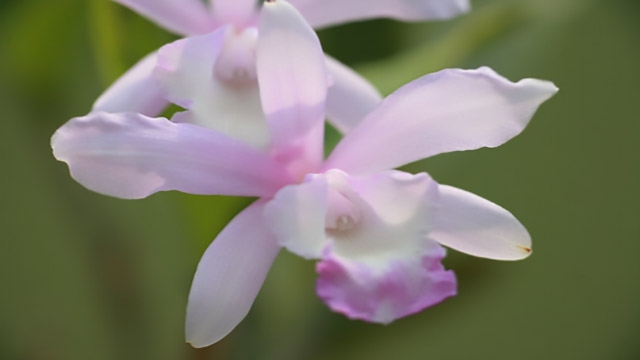
1.追肥条件
首先要确定温度在十五和三十之间,这样是比较适合追肥的。不在这一个区间就需要谨慎对待。生长期可以给它追加氮肥,结花果的时候可以追加钾磷肥。追肥不能在夏天还有秋天的中午进行,最好在没有太阳的傍晚进行。
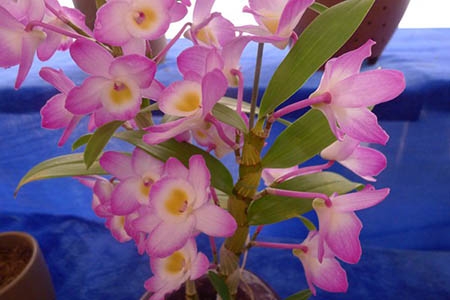
2.追肥方法
首先要将它周围的土给挖开,然后把肥料放进去,之后再把土填好浇上水就可以。如果是水溶性肥料,可以试一下将它与水溶在一起,然后对着叶子洒或者直接和水一起浇。
3.追肥原则
每一次施加少一些,可以多施加几次。
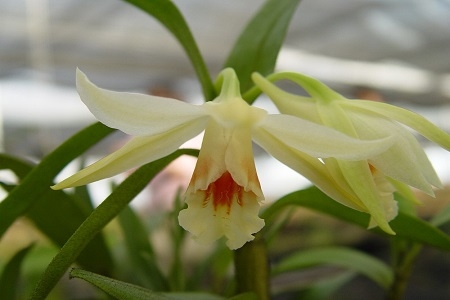
4.注意事项
①它在休眠时期会停止生长,代谢和光合都会比较差,如果我们给它追加肥料的话,它的休眠就会被打破,植株的生长也很难继续了,这样子植株的养料也会被消耗,第二年开花会受到影响。
②在它开花的时候也不可以施肥,要不然花和果都会落下,比较严重植物还可能死掉。
③新栽的也不可以给它施加肥料,因为伤口很多,被刺激后很难愈合,根就会烂掉。
④不能在它的根部下面施肥,这样吸收还有利用会比较难,要根据植株的生长情况于离它根比较远的地方施加。
⑤不能够给它施加浓肥或生肥,要不然会枯死,而且还会有臭气。
⑥要注意营养全面,如果只给它施加氮肥,它的开花时间会推迟,而且花会长得不好看。
⑦病弱的植株是不能随便施肥的,对它有害。而种子时期也不用给它施肥,等到长出真正的叶子再施肥。

0
1
文章
权问薇
2018年05月25日

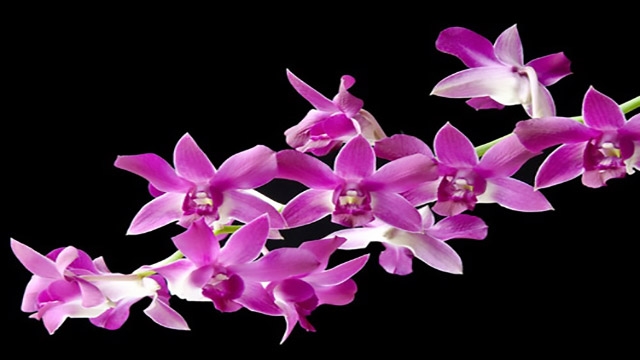
1.光照
光照对它的开花有比较大的影响,光照的时间和强度对它都有影响。不管气温如何,只有给予了它短日照,它的花芽都会形成。当它的花芽分化,就可以适当增加光照。最好每天上午八点到五点给它光,其余的时间让它在阴暗的环境里度过,这样开花效果会更好。

2.花盆
比较窄小的素烧盆对它而言可以保湿也可以疏水,这样植株不会烂根。最好再在盆底加上一些木炭,这能让它长得更好。

3.肥料
不能给它施加浓肥,要不然它的根会烂掉,对于肥料也很难吸收。等到春天来的时候,可以给它加一些比较淡薄的液肥后,两个星期就可以给它加一些磷肥和钾肥。这样它的根会比较粗壮,吸收能力也会好很多,对花的开放很有用。
4.空气
如果不给它通风条件,它的花会开得比较差。平时我们可以将它置于流通的空气中,并且可以向叶子和周围洒水。

0
1
文章
Miss Chen
2018年05月24日

Description: This herbaceous perennial plant is about 1¼-3' tall and usually unbranched, except toward the apex where the flowers occur. The central stem is light green, terete, and glabrous to slightly hairy. The alternate leaves are up to 4" long and 1¾" across, becoming gradually smaller as they ascend the stems. They are lanceolate to ovate, serrated along their margins, and pinnately veined. The upper leaf surface is medium green and glabrous to sparsely short-pubescent, while the lower surface is light green and mostly glabrous, except for some hairs along the major veins. The bases of lower leaves taper into short winged petioles, while the bases of upper leaves are sessile. The tips of leaves are mostly acute (less often bluntly acute). The central stem terminates in a panicle of flowerheads up to 1' tall and 1' across. The major branches of this panicle are arching, widely spreading, and racemose (raceme-like in appearance). The flowerheads are borne on short lateral branchlets along the major branches, facing upward; they are nearly sessile. Both the branches and branchlets are light to medium green and pubescent. The panicle is rather open in structure and it often causes the entire plant to lean over because of the weight of the flowerheads.
Each flowerhead is about 3 mm. (1/8") across, consisting of several ray florets (3-8) that surround a similar number of disk florets. Both the petaloid rays and corollas of the florets are yellow; the petaloid rays are linear-oblong, while the corollas are short-tubular and minutely lobed above. Surrounding the base of each flowerhead, there are several overlapping series of phyllaries (scaly floral bracts); these phyllaries are light green to yellowish green, appressed together, and linear-lanceolate in shape. In addition to the flowerheads, small leafy bracts (up to 1" long) occur along the branches and branchlets of the panicle. On robust plants, smaller secondary panicles or racemes of flowerheads often develop from the axils of upper leaves. The blooming period occurs from late summer to early fall and lasts about 3-4 weeks. Afterwards, fertile florets are replaced by small achenes with tufts of hair at their apices. These achenes are oblongoid in shape and 2-3 mm. long; they are dispersed by the wind. The root system consists of a branching caudex with secondary fibrous roots; rhizomes are also produced, enabling this plant to form clonal colonies.

Cultivation: The preference is light shade to partial sun, moist to slightly dry conditions, and soil containing loam, sandy loam, glacial till, or some rocky material. This goldenrod readily adapts to cultivation and it should be planted in gardens more often.
Range & Habitat: The native Elm-Leaved Goldenrod is a common plant that has been observed in nearly all counties of Illinois (see Distribution Map). Among woodland goldenrods (Solidago spp.), it is the most common species in the state. Habitats include mesic to upland woodlands, woodland edges, thinly wooded bluffs, edges of limestone glades, partially shaded banks of rivers, and thickets. This goldenrod can spread to edges of lawns in semi-shaded areas from adjacent woodlands. It is found in both higher quality and degraded habitats. Wildfires and other kinds of disturbance are beneficial if they reduce excessive shade from overhead canopy trees and competing shrubs.

Faunal Associations: The flowers attract various kinds of bees, wasps, and flies. These insects seek nectar; bees also collect pollen. Among the bees, are such floral visitors as miner bees (Melissodes spp.), Halictid bees, masked bees (Hylaeus spp.), plasterer bees (Colletes spp.), Andrenid bees, dagger bees (Panurginae), and leaf-Cutting bees (Megachile spp.). Many insects feed destructively on Elm-Leaved Goldenrod and other goldenrods (Solidago spp.); this includes Sumitrosis inaequalis and other leaf beetles, the Goldenrod Plant Bug (Lopidea media) and other plant bugs, the Green Stink Bug (Acrosternum hilaris) and other stink bugs, the Goldenrod Lace Bug (Corythucha marmorata), Acuticauda solidaginifoliae and other aphids, various leafhoppers and treehoppers, and caterpillars of the Goldenrod Flower Moth (Schinia nundina) and many other moths (see the Moth Table). Some vertebrate animals also feed on goldenrods. For example, the Ruffed Grouse, Cottontail Rabbit, and White-Tailed Deer browse on the foliage occasionally, while such granivorous songbirds as the Eastern Goldfinch, Slate-Colored Junco, and Tree Sparrow eat the seeds during the autumn and winter.

Photographic Location: At the edge of a wooded area in Crystal Lake Park, Urbana, Illinois.
Comments: This woodland goldenrod has a terminal inflorescence that is rather lanky and spreading, while its lower leaves are lanceolate-ovate and coarsely serrated (superficially resembling the leaves of American Elm, but more narrow and thin-textured). Elm-Leaved Goldenrod is similar in appearance to Canada Goldenrod (Solidago canadensis), but the latter has lower leaves with 3 parallel veins (a central vein and two lateral veins). Canada Goldenrod also has more hairy leaves and stems, and the major branches of its panicles are usually less divergent than those of Elm-Leaved Goldenrod. Other goldenrods (Solidago spp.) can be distinguished by some combination of characteristics involving the appearance of their leaves, stems, or inflorescences. Because there are many goldenrod species in Illinois, they can be difficult to distinguish.
Each flowerhead is about 3 mm. (1/8") across, consisting of several ray florets (3-8) that surround a similar number of disk florets. Both the petaloid rays and corollas of the florets are yellow; the petaloid rays are linear-oblong, while the corollas are short-tubular and minutely lobed above. Surrounding the base of each flowerhead, there are several overlapping series of phyllaries (scaly floral bracts); these phyllaries are light green to yellowish green, appressed together, and linear-lanceolate in shape. In addition to the flowerheads, small leafy bracts (up to 1" long) occur along the branches and branchlets of the panicle. On robust plants, smaller secondary panicles or racemes of flowerheads often develop from the axils of upper leaves. The blooming period occurs from late summer to early fall and lasts about 3-4 weeks. Afterwards, fertile florets are replaced by small achenes with tufts of hair at their apices. These achenes are oblongoid in shape and 2-3 mm. long; they are dispersed by the wind. The root system consists of a branching caudex with secondary fibrous roots; rhizomes are also produced, enabling this plant to form clonal colonies.

Cultivation: The preference is light shade to partial sun, moist to slightly dry conditions, and soil containing loam, sandy loam, glacial till, or some rocky material. This goldenrod readily adapts to cultivation and it should be planted in gardens more often.
Range & Habitat: The native Elm-Leaved Goldenrod is a common plant that has been observed in nearly all counties of Illinois (see Distribution Map). Among woodland goldenrods (Solidago spp.), it is the most common species in the state. Habitats include mesic to upland woodlands, woodland edges, thinly wooded bluffs, edges of limestone glades, partially shaded banks of rivers, and thickets. This goldenrod can spread to edges of lawns in semi-shaded areas from adjacent woodlands. It is found in both higher quality and degraded habitats. Wildfires and other kinds of disturbance are beneficial if they reduce excessive shade from overhead canopy trees and competing shrubs.

Faunal Associations: The flowers attract various kinds of bees, wasps, and flies. These insects seek nectar; bees also collect pollen. Among the bees, are such floral visitors as miner bees (Melissodes spp.), Halictid bees, masked bees (Hylaeus spp.), plasterer bees (Colletes spp.), Andrenid bees, dagger bees (Panurginae), and leaf-Cutting bees (Megachile spp.). Many insects feed destructively on Elm-Leaved Goldenrod and other goldenrods (Solidago spp.); this includes Sumitrosis inaequalis and other leaf beetles, the Goldenrod Plant Bug (Lopidea media) and other plant bugs, the Green Stink Bug (Acrosternum hilaris) and other stink bugs, the Goldenrod Lace Bug (Corythucha marmorata), Acuticauda solidaginifoliae and other aphids, various leafhoppers and treehoppers, and caterpillars of the Goldenrod Flower Moth (Schinia nundina) and many other moths (see the Moth Table). Some vertebrate animals also feed on goldenrods. For example, the Ruffed Grouse, Cottontail Rabbit, and White-Tailed Deer browse on the foliage occasionally, while such granivorous songbirds as the Eastern Goldfinch, Slate-Colored Junco, and Tree Sparrow eat the seeds during the autumn and winter.

Photographic Location: At the edge of a wooded area in Crystal Lake Park, Urbana, Illinois.
Comments: This woodland goldenrod has a terminal inflorescence that is rather lanky and spreading, while its lower leaves are lanceolate-ovate and coarsely serrated (superficially resembling the leaves of American Elm, but more narrow and thin-textured). Elm-Leaved Goldenrod is similar in appearance to Canada Goldenrod (Solidago canadensis), but the latter has lower leaves with 3 parallel veins (a central vein and two lateral veins). Canada Goldenrod also has more hairy leaves and stems, and the major branches of its panicles are usually less divergent than those of Elm-Leaved Goldenrod. Other goldenrods (Solidago spp.) can be distinguished by some combination of characteristics involving the appearance of their leaves, stems, or inflorescences. Because there are many goldenrod species in Illinois, they can be difficult to distinguish.
0
0






